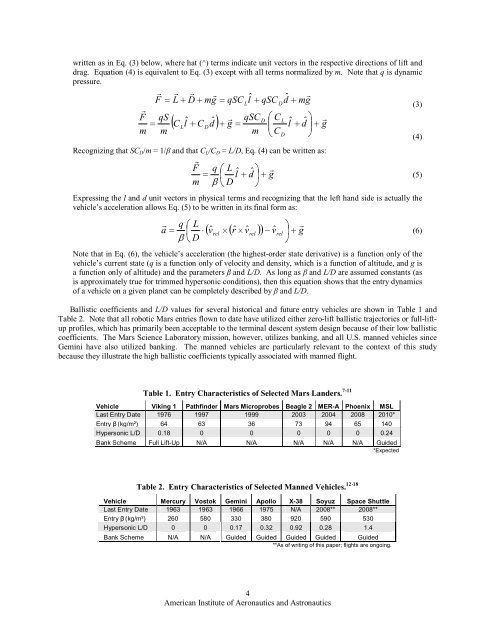Mars Entry Bank Profile Design for Terminal State Optimization
Mars Entry Bank Profile Design for Terminal State Optimization
Mars Entry Bank Profile Design for Terminal State Optimization
Create successful ePaper yourself
Turn your PDF publications into a flip-book with our unique Google optimized e-Paper software.
written as in Eq. (3) below, where hat (^) terms indicate unit vectors in the respective directions of lift and<br />
drag. Equation (4) is equivalent to Eq. (3) except with all terms normalized by m. Note that q is dynamic<br />
pressure.<br />
r r r r<br />
r<br />
F= L+<br />
D+<br />
mg=<br />
qSC<br />
Ll<br />
ˆ+<br />
qSC<br />
Dd<br />
ˆ+<br />
mg<br />
(3)<br />
r<br />
F qS r qSC<br />
D<br />
⎛ C<br />
L<br />
⎞ r<br />
= ( C lˆ<br />
L<br />
+ C dˆ<br />
D<br />
) + g = l d + g<br />
m m<br />
m<br />
⎜ ˆ + ˆ<br />
C<br />
⎟<br />
⎝ D ⎠<br />
(4)<br />
Recognizing that SC D /m = 1/β and that C L /C D = L/D, Eq. (4) can be written as:<br />
r<br />
F q ⎛ L ⎞ r<br />
= ⎜ lˆ<br />
+ dˆ<br />
⎟ + g<br />
m β ⎝ D ⎠<br />
Expressing the l and d unit vectors in physical terms and recognizing that the left hand side is actually the<br />
vehicle’s acceleration allows Eq. (5) to be written in its final <strong>for</strong>m as:<br />
r q ⎛ L<br />
a = ⎜ ⋅<br />
ˆ<br />
rel<br />
rel<br />
β ⎝ D<br />
( vˆ<br />
× ( rˆ<br />
× vˆ<br />
)) − v g<br />
Note that in Eq. (6), the vehicle’s acceleration (the highest-order state derivative) is a function only of the<br />
vehicle’s current state (q is a function only of velocity and density, which is a function of altitude, and g is<br />
a function only of altitude) and the parameters β and L/D. As long as β and L/D are assumed constants (as<br />
is approximately true <strong>for</strong> trimmed hypersonic conditions), then this equation shows that the entry dynamics<br />
of a vehicle on a given planet can be completely described by β and L/D.<br />
Ballistic coefficients and L/D values <strong>for</strong> several historical and future entry vehicles are shown in Table 1 and<br />
Table 2. Note that all robotic <strong>Mars</strong> entries flown to date have utilized either zero-lift ballistic trajectories or full-liftup<br />
profiles, which has primarily been acceptable to the terminal descent system design because of their low ballistic<br />
coefficients. The <strong>Mars</strong> Science Laboratory mission, however, utilizes banking, and all U.S. manned vehicles since<br />
Gemini have also utilized banking. The manned vehicles are particularly relevant to the context of this study<br />
because they illustrate the high ballistic coefficients typically associated with manned flight.<br />
rel<br />
⎞<br />
⎟ +<br />
⎠<br />
r<br />
(5)<br />
(6)<br />
Table 1. <strong>Entry</strong> Characteristics of Selected <strong>Mars</strong> Landers. 7-11<br />
Vehicle Viking 1 Pathfinder <strong>Mars</strong> Microprobes Beagle 2 MER-A Phoenix MSL<br />
Last <strong>Entry</strong> Date 1976 1997 1999 2003 2004 2008 2010*<br />
<strong>Entry</strong> β (kg/m²) 64 63 36 73 94 65 140<br />
Hypersonic L/D 0.18 0 0 0 0 0 0.24<br />
<strong>Bank</strong> Scheme Full Lift-Up N/A N/A N/A N/A N/A Guided<br />
*Expected<br />
Table 2. <strong>Entry</strong> Characteristics of Selected Manned Vehicles. 12-18<br />
Vehicle Mercury Vostok Gemini Apollo X-38 Soyuz Space Shuttle<br />
Last <strong>Entry</strong> Date 1963 1963 1966 1975 N/A 2008** 2008**<br />
<strong>Entry</strong> β (kg/m²) 260 580 330 380 920 590 530<br />
Hypersonic L/D 0 0 0.17 0.32 0.92 0.28 1.4<br />
<strong>Bank</strong> Scheme N/A N/A Guided Guided Guided Guided Guided<br />
**As of writing of this paper; flights are ongoing.<br />
4<br />
American Institute of Aeronautics and Astronautics
















